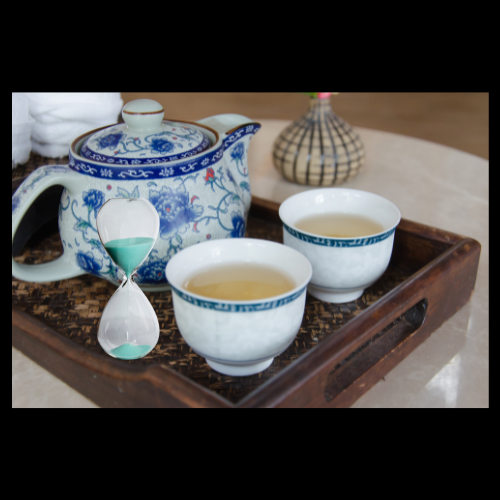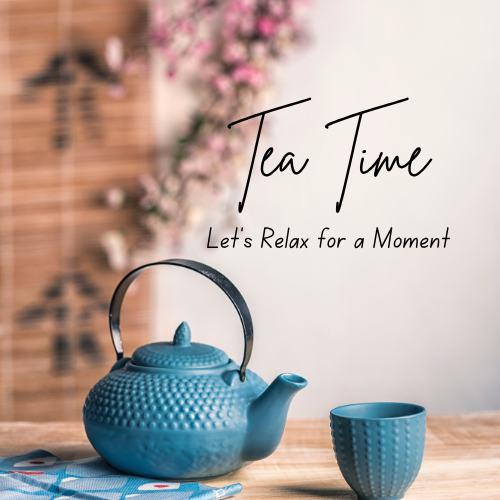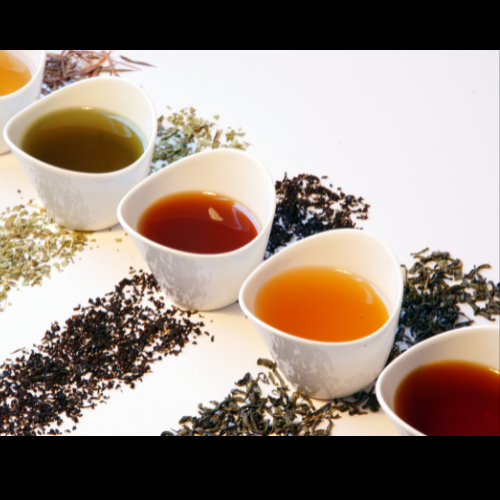“You’re Probably Wasting 80% of Your Herbal Tea’s Power—Here’s Why”: A Deep Dive into Steep Times, Synergies, and Herbal Potency
Jul 2nd 2025
You’re Probably Wasting 80% of Your Herbal Tea’s Power—Here’s Why
Ever read a tea blog that says "steep for 5–10 minutes" and calls it a day? You deserve better. Brewing herbal teas isn't a one-size-fits-all process. If you're investing in quality herbs for energy, digestion, sleep, or skin support, then how you brew matters. A lot.
This guide will help you go beyond the basics. You'll learn why steep time matters, what Traditional Chinese Medicine (TCM) teaches, which herb combos actually work, and how to steep smarter—not just longer.
The Truth About Steep Times: It’s Not One-Size-Fits-All
Here’s what most tea blogs won’t tell you: steeping a delicate flower like chrysanthemum isn’t the same as brewing a dense root like astragalus. Different plant parts require different:
-
Water temperatures
-
Steep durations
-
Preparation methods (infusion vs. decoction)
General steep-time tips:
-
Leaves & flowers: 2–10 minutes in hot (not boiling) water
-
Barks & roots: 20–45 minutes simmered gently
-
Seeds & berries: 10–20 minutes steeped or lightly simmered
Want precision? Use our Steep-Time Calculator
What TCM Teaches About Tea (and Why It Matters)
In Traditional Chinese Medicine (TCM), herbal tea isn’t just a cozy bedtime ritual or a flavorful health boost. It’s a precise, energetic practice—one that treats the body as a dynamic system and each herb as a strategic intervention.
Every herb in TCM carries multiple layers of meaning and therapeutic intention. To brew it properly, you must understand not just what the herb does, but how it behaves in the body.
Temperature Matters
Herbs are classified by their energetic temperature—not how hot they feel, but how they affect the body’s internal balance.
-
Hot and warm herbs (like cinnamon or ginger) stimulate, move Qi, and dispel cold
-
Cool and cold herbs (like chrysanthemum or mint) clear heat, reduce inflammation, and calm agitation
-
Neutral herbs gently support without pushing extremes
Brew tip: Warming herbs are often simmered to release their deep tones, while cooling herbs are gently steeped to preserve delicate compounds.
Taste Isn’t Just Flavor—It’s Function
In TCM, each taste corresponds to a therapeutic direction:
-
Sweet: Nourishes, harmonizes, and tonifies (e.g., licorice, goji berry)
-
Bitter: Drains excess, clears heat, and dries dampness (e.g., dandelion root)
-
Pungent (Spicy): Disperses stagnation and moves Qi (e.g., ginger, mint)
-
Sour: Astringes and stabilizes fluids (e.g., schisandra)
-
Salty: Softens hardness, moistens dryness (e.g., kelp)
Brew tip: Taste tells you how long and how strongly to extract an herb. Sweet and pungent herbs often act fast, while bitter or salty herbs may require deeper decoction.
Organ System Affinity
Each herb targets one or more internal organs, or “zang-fu” systems, based on its Qi movement and nature:
-
Goji berry (Gou Qi Zi) targets the Liver and Kidney to nourish blood and yin
-
Astragalus (Huang Qi) enters the Spleen and Lung to boost Qi and immunity
-
Mint (Bo He) enters the Lung and Liver to move constrained Qi and cool heat
Brew tip: Understanding an herb’s organ targets helps you combine it with others for synergy or avoid over-tonifying a specific system.
Function = The Herb’s “Job Description”
TCM classifies herbs based on their core function. Some common ones include:
-
Tonifying (Qi, Blood, Yin, Yang)
-
Releasing the Exterior (to fight early-stage colds)
-
Clearing Heat and Detoxifying
-
Moving Qi or Blood
-
Calming the Spirit (Shen)
Proper brewing methods support those functions. You wouldn’t just toss an herb in hot water and hope—it’s about unlocking its therapeutic potential.
Example: Steeping Astragalus for 3 minutes in lukewarm water? You’re missing 80% of its immune-boosting compounds. It needs time, heat, and intention—at least 30 minutes in a gentle simmer to extract its full Qi-tonifying properties.
Bottom Line: Brewing = Respecting the Medicine
When you understand the TCM view of herbs, you stop treating tea like a beverage—and start treating it like the healing system it is. Every herb carries direction, intention, and purpose. Brew it accordingly, and you’ll experience results no tea bag can deliver.
 On A Personal Note About Green Tea
On A Personal Note About Green Tea
My Green Tea Wake-Up Call: From Bitter Regret to Daily Must Have.
I’ll admit it—when I first tried green tea, I hated it.
Everyone around me raved about how calming and cleansing it was. I wanted to love it. I wanted to be that person, effortlessly sipping green tea in the morning, glowing from the inside out. But every cup I brewed tasted like bitter disappointment… and soggy lawn clippings.
So I gave up—until I learned the truth: It wasn’t the tea. It was how I was brewing it.
Like so many beginners, I poured boiling water over my delicate green leaves and steeped it for far too long. No wonder it tasted awful. Once I realized green tea needs lower water temperatures—around 160–180°F—and a short steep (just 1–3 minutes), everything changed. My fancy timer changed everything.
The bitterness vanished. The subtle flavor came through. And that jittery, crashy caffeine buzz I used to get from coffee? Replaced by a gentle, focused calm that actually lasted.
Now, brewing green tea the right way has become a small, daily ritual that feels like a quiet celebration. It’s not just about taste—it’s about intention, awareness, and giving your body what it actually needs.
Teas That Work Better Together: Herbal Synergies That Deliver
Most blogs list single herbs. We teach synergy. Here’s how to combine them for targeted results:
1. Energy & Immunity Boost
-
Astragalus (Huang Qi) + Codonopsis (Dang Shen): Qi support
-
Add Goji Berries (Gou Qi Zi) to nourish Liver Blood and eyesight
2. Sleep & Stress Relief
-
Suan Zao Ren + Bai Zi Ren + Licorice root: Calms the Heart and nervous system
3. Digestive Support
-
Chen Pi + Shan Zha + Hawthorn Berry: Breaks down food stagnation and bloating
4. Hydration & Skin Glow
-
Goji berries + Chia seeds + Mint leaves: Boosts yin fluids and internal cooling
Balance tip: Always pair warming with cooling when needed. Match Qi with Blood herbs. And never underestimate the power of a good harmonizer like licorice.
❌ Common Brewing Mistakes (and How to Fix Them)
-
❌ Using boiling water on fragile flowers
-
❌ Tossing herbs after one steep (roots often give 2–3)
-
❌ Brewing all herbs the same way
-
❌ Believing herbal tea should taste like a spa
Fix these, and your tea actually starts working.
Brewing Tips Based on Plant Type
| Plant Part | Steep/Simmer Time | Best Temp | Notes |
|---|---|---|---|
| Flowers | 5–10 min | 180°–185°F | Steep covered to trap oils |
| Leaves | 8–15 min | 185°–195°F | Stir mid-steep |
| Roots/Barks | 30–45 min | Simmer (200°F+) | Use decoction method |
| Berries/Seeds | 10–20 min | 190°–205°F | Steep or light simmer with lid on |
Herbs That Shouldn’t Be Boiled
-
Chrysanthemum, Chamomile, Peppermint: Volatile oils are damaged
-
Ginseng: Delicate saponins can be destroyed with high heat
-
Licorice root: Benefits most from decoction
Steep smarter. Protect your herbs’ chemistry.
Interactive Brewing Tool: Our Steep-Time Calculator
Use our free steep-time calculator to match each herb to its best prep method. Based on pharmacopoeia data.
Customer Testimonials
"I thought herbal tea was just for flavor. Then I started brewing the way you taught—wow. My energy tea actually worked."
— Rachel M., Oregon
"I had no clue steeping time could make or break a blend. Your steep-time calculator changed the way I brew."
— Ken T., New York
"Your herbs and your guidance have done more for my digestion than anything I’ve tried. I even sleep better now." — Maria L., Arizona
FAQs: What Most Tea Drinkers Still Wonder
Q: Can I reuse herbs?
A: Yes! Especially roots, barks, and berries. You can often get 2–3 steeps.
Q: Should I cover my cup while steeping?
A: Always. It helps retain volatile oils and full potency.
Q: Can I mix my own formulas?
A: Yes, but follow the Chief-Assistant-Harmonizer model used in TCM formulas. Need help? Use our blend kits or ask an herbalist.
Q: Why does my tea taste different every time?
A: Water quality, steeping time, herb freshness, and temperature all play a role.
Q: How do I know if I should simmer or steep?
A: Use our calculator, or follow this rule: If it's dense (root/bark), simmer. If it's light (leaf/flower), steep.
 Final Thoughts: Steep with Purpose
Final Thoughts: Steep with Purpose
Drinking herbal tea is more than cozy vibes. It’s medicine, tradition, chemistry, and intention. Learn to brew with care, and you unlock the full potential of your herbs.
Next time someone tells you "steep for 5 minutes," smile. Then show them how it’s really done.
Ready to get serious about your teas? Shop premium brewing herbs
Want perfect results every time? Use our Steep-Time Calculator


